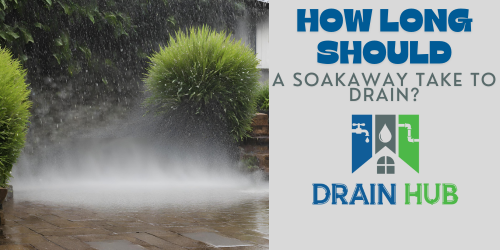This obviously depends on many individual factors to do with location, design and age, but generally, soakaways should have drained within 24hrs.
This is the time for the soakaway itself to drain; if your rainwater drainage is taking longer to dissipate from the ground or gutters, there may be problems between the drain and soakaway.
There are many properties across the UK with smaller than ideal soakaways from when the weather behaved…differently. Theses days, rainwater systems are expected to take a lot more in one go – rather than a drizzly amount over a longer period.
If your property has a soakaway, this works by dispersing surface water (from the rain being collected via gutters, gullies and channel drainage) into the surrounding soil, preventing waterlogging around foundations & structures, and helping reduce flood risks.
When the water hits the soakaway, it stores it before dispersing it into the earth, making it more manageable and in a way that should reduce too much movement too quickly, or too rapid soaking and drying. The speed at which the rain water “percolates” into the ground depends the permeability of the local ground.
Hopefully your soakaway was a considered design and not simply a gravel pit made of builders rubble, which in my experience was common practice decades ago. Not that I made them that way, I mean some of the exhausted soakaways I’ve found which turned out to be just that – a load of pea shingle and old bricks thrown in the ground with a pipe leading to it from the nearest downpipe or gully.
Hopefully the information below will help you determine what shape your soakaway might be in.
Factors Influencing Drainage Time:
Expected Drainage Times:
Drainage times for soakaways can vary significantly based on soil type and specific soakaway characteristics:
Soil Type:
- Sandy Soil:
Highly permeable, sandy soils can drain water within a few hours, typically making them ideal for quick dispersal. - Loamy Soil:
Offering a balance of permeability and nutrient retention, loamy soils may take several hours to a full day to drain. - Clay Soil:
Due to its low permeability, clay can take significantly longer, potentially several days, depending on the saturation level and compaction.
Soakaway Size and Design:
- A larger or more appropriately designed soakaway can handle higher volumes of water more efficiently, reducing drainage time. Conversely, undersized or poorly designed systems will experience slower drainage times.
Regulations and Standards:
- In the UK, the design and implementation of soakaways must comply with Building Regulations Part H, which stipulates that soakaways should be designed to empty within 24 hours, primarily to minimize the risk of mosquito breeding. Design calculations often follow the guidelines set out in BS EN 752 or the BRE Digest 365, ensuring that the soakaway is suitable for the expected rain intensity and soil conditions of the area.
Understanding these factors and adhering to regulatory standards ensures that soakaways function efficiently, managing water runoff effectively while complying with environmental and safety requirements.
Enhancing Drainage Efficiency
To help prolong the life of your soakaway and prevent blockages and any other issues before they pop up, regular maintenance and periodic checks are very handy, and likely more cost effective in the long run.
Not sure if you have a soakaway or how it works?
If you want to check your soakaway, or even confirm you have one, contacting a drainage contractor and asking for a CCTV survey to investigate is the way to go.
This way, you get a plan of the property and where the soakaway is, and footage showing the condition of the pipe work leading to the soakaway.
The pipes may need clearing if they’re starting to collect silt, for example, or there could be signs of ground movement if some joints are displaced. This shouldn’t mean panic is needed, far from it – it just shows you the condition of your drainage so you have a benchmark to compare against.
Cleaning the pipes with high pressure water will remove silt, leaves and sediment and shouldn’t take long depending on access to the system and how close the jetting vehicle can get to it, and shouldn’t really be needed more than once a year for a private property or even a small commercial building.
As for structure, any displaced joints may have been there from day 1, so just regular checking will confirm if there is movement or cause for concern.
Once you have a plan and information on your soakaway, you’ll be better armed for dealing with problems.

| Field Name | Description |
|---|---|
| Ground or Lawn Condition | Describe the condition of the ground or lawn |
| Do gutters and gullies cope with sudden downpours and light rain? | Select if the drainage systems are adequate for both sudden downpours and light rain |
| Is the area waterlogged after a storm? | Indicate if the area remains waterlogged after a storm |
| Additional Observations | Any other observations or notes |
Need more information on soakaways? There’s more!


Leave a Reply